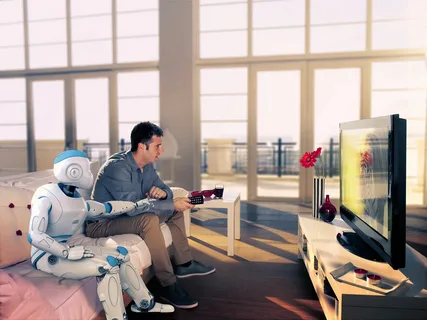As technology continues to advance, the integration of robotics into our daily lives is becoming increasingly prevalent. From smart homes to healthcare and beyond, robots are evolving to play diverse roles, making tasks more efficient, and enhancing overall convenience. Let’s explore the exciting trajectory of The Future of Robotics in Everyday Life and the transformative impact it holds.
I. Smart Homes and Domestic Assistants
Robotic Vacuum Cleaners
The future envisions a seamless integration of robotic vacuum cleaners that autonomously navigate homes, ensuring floors are effortlessly cleaned without manual intervention. These smart devices adapt to household layouts, optimizing cleaning routes for maximum efficiency.
Personalized Home Assistants
Robotic home assistants will evolve to become more personalized and intuitive. Equipped with advanced AI, these robots can manage household tasks, control smart home devices, and even engage in conversations to provide information and assistance.
II. Healthcare and Medical Assistance
Surgical Robots
The future of healthcare involves the widespread adoption of surgical robots. These highly precise machines, controlled by skilled surgeons, enhance the precision of medical procedures, reduce invasiveness, and contribute to faster recovery times.
Robotic Prosthetics and Rehabilitation Aids
Advancements in robotics will lead to more sophisticated prosthetics and rehabilitation aids. These devices will offer enhanced mobility and functionality, closely mimicking natural movements and significantly improving the quality of life for individuals with limb impairments.
III. Autonomous Transportation
Self-Driving Vehicles
Autonomous vehicles are poised to become an integral part of everyday life. From self-driving cars to autonomous delivery drones, these robots will transform transportation, making it safer, more efficient, and accessible to a broader range of individuals.
Personal Mobility Robots
Compact, personal mobility robots will navigate urban environments, providing a convenient and eco-friendly alternative for short-distance travel. These robots may be used for commuting, shopping, or leisure, contributing to reduced traffic congestion.
IV. Educational Robots
AI-Powered Tutoring Robots
Educational robots equipped with artificial intelligence will serve as personalized tutors. These robots can adapt to individual learning styles, providing tailored lessons and support to students, fostering a more effective and engaging learning experience.
Programming and STEM Education
Robotics will play a crucial role in STEM education. Students will interact with programmable robots, learning coding and problem-solving skills in a hands-on, practical manner, preparing them for future careers in technology.
V. Social Robots and Companionship
Companion Robots for the Elderly
Robotic companions will provide emotional support and assistance to the elderly. These robots may help with daily tasks, monitor health, and offer companionship, addressing challenges associated with an aging population.
Social Interaction Robots
In the future, robots designed for social interaction will become more prevalent. These robots will engage in conversations, recognize emotions, and offer companionship, particularly in situations where human interaction may be limited.
VI. Environmental Monitoring and Maintenance
Agricultural Robots
Agricultural robots equipped with sensors and AI will revolutionize farming practices. These robots can monitor crop health, optimize irrigation, and perform tasks such as planting and harvesting, contributing to increased efficiency in agriculture.
Oceanic and Atmospheric Robots
Robotic devices will be employed for environmental monitoring in remote or challenging locations. These robots can collect data on oceanic conditions, atmospheric changes, and wildlife behavior, aiding in environmental research and conservation efforts.
VII. Workplace Automation and Collaboration
Collaborative Robots (Cobots)
Collaborative robots, or cobots, will work alongside humans in various industries. These robots can assist with repetitive tasks, enhance productivity, and contribute to safer working environments through effective human-robot collaboration.
Robotic Telepresence in Remote Work
Robotic telepresence will enable remote workers to have a physical presence in the workplace. These robots, equipped with cameras and screens, allow users to navigate office spaces and interact with colleagues in real-time.
VIII. Ethical Considerations and Regulations
Ethical Use of Robots
As robots become more integrated into daily life, discussions on ethical considerations will gain prominence. Debates on issues like privacy, job displacement, and robot rights will shape how societies navigate the ethical use of robotic technologies.
Regulatory Frameworks
Governments and organizations will develop regulatory frameworks to ensure the responsible deployment and use of robots. These regulations will address safety standards, data privacy, and ethical guidelines to mitigate potential risks associated with widespread robotic integration.
IX. Conclusion
In conclusion, the future of robotics in everyday life is marked by a diverse range of applications that enhance efficiency, convenience, and quality of life. From smart homes to healthcare, education, transportation, and environmental monitoring, robots are poised to play integral roles in shaping the way we live, work, and interact. As we embrace these technological advancements, careful consideration of ethical implications and the development of robust regulatory frameworks will be essential to ensure a harmonious integration of robots into our everyday lives.
FAQs
- How will robotic vacuum cleaners evolve in the future? Robotic vacuum cleaners will evolve to autonomously navigate homes, adapting to layouts for optimal cleaning routes. They will become more intuitive, providing a seamless and efficient cleaning experience.
- What role will surgical robots play in the future of healthcare? Surgical robots will become more widespread, enhancing the precision of medical procedures, reducing invasiveness, and contributing to faster recovery times. Skilled surgeons will control these robots during medical interventions.
- How will robotics impact education in the future? Educational robots equipped with artificial intelligence will serve as personalized tutors, adapting to individual learning styles. Robotics will also play a crucial role in STEM education, offering hands-on learning experiences in coding and problem-solving.
- What are some future applications of robotic telepresence in the workplace? Robotic telepresence will enable remote workers to have a physical presence in the workplace. These robots, equipped with cameras and screens, will allow users to navigate office spaces and interact with colleagues in real-time.
- How will ethical considerations be addressed in the future of robotics? Discussions on ethical considerations, including privacy, job displacement, and robot rights, will become more prominent. Governments and organizations will develop regulatory frameworks to ensure responsible deployment and use of robots, addressing safety standards and ethical guidelines.
